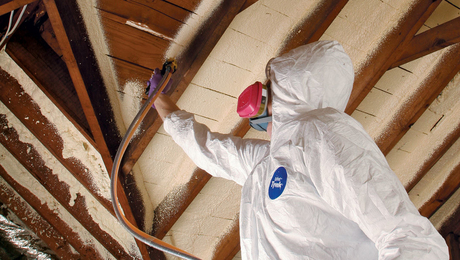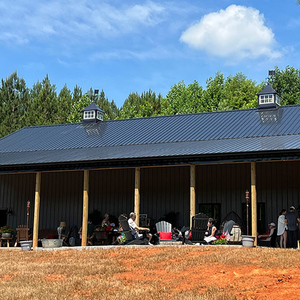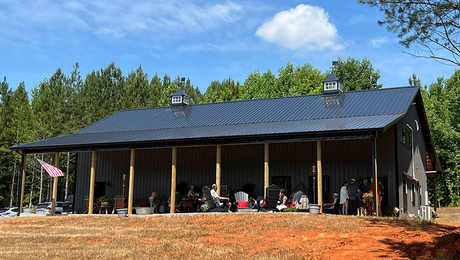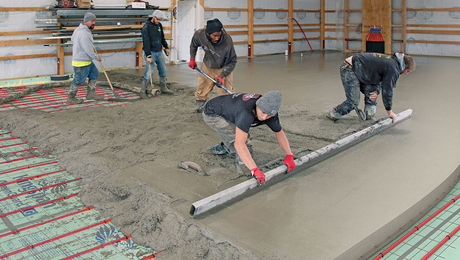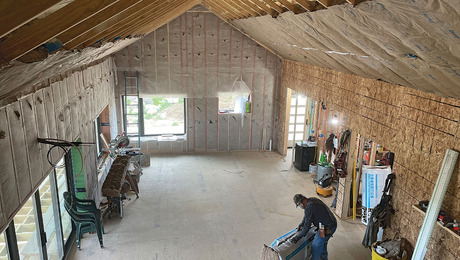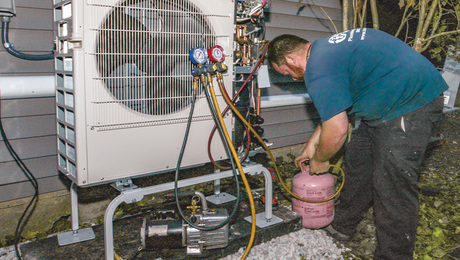The Fine Homebuilding Interview: Allison A. Bailes III
This Georgian author and educator brings building science down to Earth.
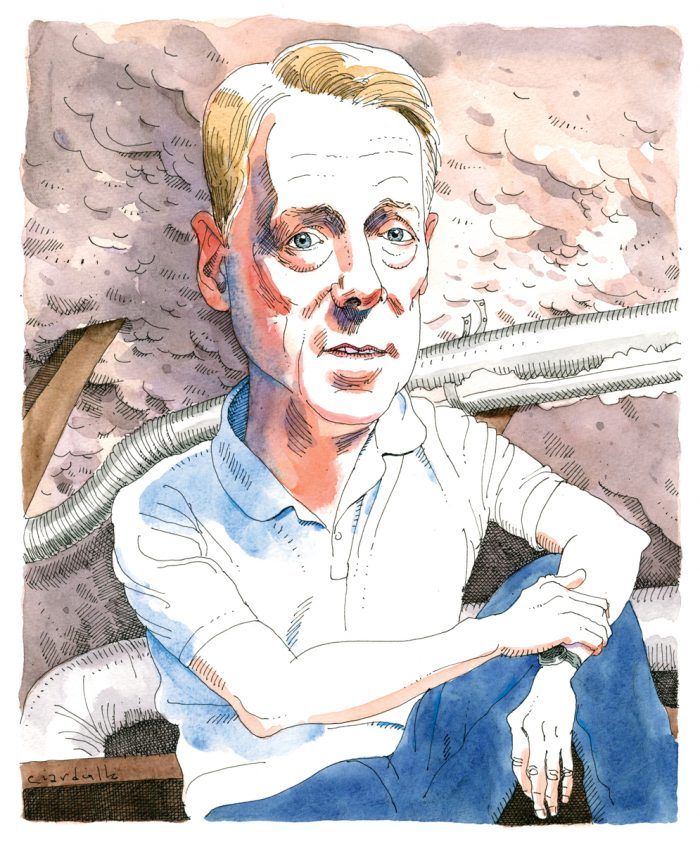
Synopsis: Allison A. Bailes III is most well-known for his Energy Vanguard blog, where he discusses everything from building science fundamentals to particulars of HVAC design. In this interview, former editor Aaron Fagan talks to Allison about the myths and misinformation that are prevalent in the building industry, what we are getting right as an industry (air-sealing) and where we still have room to grow (our understanding and use of mechanical systems), and the challenges to building healthy homes in the midst of growing climate and economic concerns.
Allison A. Bailes III, PhD, is founder and owner of Energy Vanguard—a home-energy education, design, and consulting firm—in Decatur, Ga. His academic credentials in physics (he has a BS, MS, MST, and PhD all in that field) give him a solid foundation in the science that underlies building science and green building. And having taught physics at the high school and college levels, he’s adept at explaining technical concepts in a way that people new to these disciplines can understand.
He has the practical, hands-on experience of having built a high-performance home out of structural insulated panels, doing much of the work himself, and he ran a home-performance contracting business. Numerous homes in the Atlanta area have had their ducts sealed and crawlspaces encapsulated by Dr. Bailes himself.
Bailes is possibly best known for his Energy Vanguard blog. In it he covers everything from building science fundamentals to HVAC particulars to big-picture topics like energy security and peak oil. The blog has gained a wide readership and his writing has now culminated in the publication of his first book, A House Needs to Breathe… Or Does It?, published in October 2022.
As a result of his varied experiences and abilities, Bailes is a highly respected teacher, speaker, and writer, praised for his ability to turn information that often comes across as dry and technical into something fun and understandable. As one of his readers commented, “Your blog is off the chain! Your writing is technical yet easily readable, such a rare combination.” He travels across North America, speaking, teaching, and leading workshops.
AF: The term “building science” gets thrown around liberally these days. It’s almost become a marketing term. Do you think of yourself as being a building scientist or a physicist?
AB: Well, I actually think of myself as neither of those. I think of myself as more of an educator than anything else. My company also does residential HVAC design, although I’m not much involved in that anymore. Mostly I do education. I write the blog. I have this book out. I have a weekly newsletter, and I do training and speaking engagements. I’m in Chicago right now for PhiusCon (the leading passive building conference in the U.S. for climate-specific zero-energy design, construction, and building science expertise), getting ready to do a technical keynote titled “Heat Pumps Make the World a Better Place.” It’s going to be a general talk about why we should use heat pumps for a bunch of different reasons including comfort, indoor-air quality, efficiency, and decarbonization.
AF: You have a reputation for letting the air out of a lot of assumptions in building. What are some of your favorite myths to debunk?
AB: Well, let’s go with the three that have received the most traffic of the articles I’ve written. I’ll start with powered attic ventilators, which I’ve been writing about since I first started writing the Energy Vanguard blog in 2010. Using a fan to blow hot air out of the attic doesn’t address the radiant heat flow from the roof to the attic floor. Much of that heat then conducts downward and finds its way into the house. The solution is air-sealing and insulation, not a fan. Some people just go nuts about that point of view: “How could you say that? I love my powered attic ventilator! It works! It keeps my house cooler! I spend less on my cooling bills!” And I’m doubtful that that’s true. Some of those people, I know, are in the business of selling powered attic ventilators because I’ve looked them up, but some of them simply want to believe it because they’ve invested money in it.
Another similar idea is ventless gas fireplaces, because these are installed in so many homes, and it’s cheaper to install a combustion appliance in your house if you don’t have to vent it to the outdoors. So, a lot of builders go that way, and currently most of the United States allows them, although California and Canada both ban them. But even when an unvented gas fireplace is working perfectly, it’s going to dump a lot of water vapor into your house. And if it’s not working perfectly, you’re also going to get a lot of nitrogen dioxide and maybe some carbon monoxide and some other bad stuff. The water vapor itself can be a problem in cold weather, because if you have a bad building enclosure, it can accumulate in materials and cause mold growth and bad indoor-air quality.
That’s two of the top three. The other one is spray-foam insulation. I think the most popular article I’ve written since I started is titled “Four Pitfalls of Spray Foam Insulation,” and it details installer errors. For example, not spraying the foam thick enough to get the proper R-value or not understanding where the building enclosure is defined and then missing some areas or putting spray foam where you don’t need it. Those three issues are always popular. There are a lot of myths around them.
AF: What are some of the other things we are getting right and some of the things we keep getting wrong in the building industry?
AB: Last December, I needed some pictures for my book. So, on a Sunday, I went to a new-construction project near where I live and walked through. It was dried in, so they had the house all framed and the windows installed, but the walls were still open. I looked around and wound up writing an article that addresses your question. The title of the article is “Building Enclosures Have Improved More Than Ducts.”
Because of energy codes in the last decade, we have required blower-door tests now. Yes, you can cheat on that, and not every building department is great about enforcing it, but in places where they do enforce it, you have to hit a specific number. And if you don’t hit it, you have to fix the building envelope.
That means builders have been doing a better job air-sealing, and we can see evidence of that. In this house that I was in, they had done a really good job of sealing behind the bathtub and around the stairwell where there’s all kinds of connections between the inside and the outside and the walls will be covered in drywall. They had established a really good air barrier in those places.
Overall, I’d say the airtightness of the building enclosure has improved a lot. Maybe the water control layer not quite as much, although that’s getting better, too. It’s easier to find the right materials like good flashing. And there’s a lot of information—that is something that has improved.
In comparison, our understanding and use of mechanical systems hasn’t improved as much. HVAC contractors still get away with pretty much whatever they want because building departments don’t have the resources and the knowledge to really understand when they’re being hoodwinked. HVAC contractors can turn in the Manual J reports and the Manual D reports, and a lot of times they actually never install what’s on those reports. They’ll just put in what they want. The reports are just for the building department. The right technologies exist, but homeowners and building departments need to hold contractors to account and ask for better solutions, which involves a learning curve for everyone.
AF: What are some of the books and periodicals that have been instrumental to you and your education?
AB: This is going to seem like a setup, but it’s absolutely true: When I was building my house 20 years ago, I discovered Fine Homebuilding, and I bought every issue as soon as it came out for a while, and then I subscribed so I could get it as soon as possible. I read the magazine cover to cover and got a lot of great information and learned some tricks about laying tile and other stuff. That was a big part of my education.
Then several years later—when I finished the house and got into the world of building science—I started to read Green Building Advisor. I discovered it shortly after it started. After I started blogging, one of the founders, Dan Morrison, invited me to post some of my articles. I’ve been doing that for more than a decade now.
And, of course, buildingscience.com—Joe Lstiburek and Betsy Pettit’s company Building Science Corporation—is an incredible source of information. They put all kinds of really good stuff out there available for free. I also use LinkedIn pretty heavily. There are people who post stuff there that I wouldn’t see otherwise. Home Energy magazine is another good resource.
AF: Did your company Energy Vanguard begin as an experiment, or did you always have a clear vision?
AB: I didn’t know which way it was going to go. I thought it might go into contracting, and I actually did a couple crawlspace encapsulations, but then what changed the direction for me and Energy Vanguard was ARRA, the American Recovery and Reinvestment Act of 2009. All the stimulus money meant lots of training, so I ended up doing HERS training and energy consulting side work. And around that time in 2010, I started the blog, which was another way of educating, because I’ve always liked writing and really wanted to do that.
That’s kind of how Energy Vanguard got where it is today with HVAC design, consulting, and education. Plus I always liked the mechanical side. Mechanicals are really neat to me because my background is in physics, so doing load calculations is not a big deal. I learned how to do the full mechanical design, and there are very few third-party companies out there doing this kind of work, so we’re in a niche without much competition right now.
AF: Tell us about your new book, A House Needs to Breathe… Or Does It?
AB: It has a lot of the stuff that I’ve written about. I actually started off trying to pull in some blog articles and then revise them as necessary, but I found that was harder than just starting from scratch. So after a while, I just started writing from scratch.
There are three main sections of the book. The first one is “Start at the End,” which is based on Robert Bean’s saying that he uses all the time: “Design for people and good buildings will follow.” So, what is it that the people in the house need? I talk about indoor environmental quality, which is the bigger category that includes indoor-air quality, sound, odors, and vibrations, all of which can affect people’s well-being inside the house. I have a whole chapter on indoor-air quality and health and then another chapter on energy efficiency.
The second section is about the building enclosure. It starts out with an introduction to building science and goes into details about controlling heat, air, and moisture, and explains control layers and how we run into all these problems because control layers often aren’t done properly. They aren’t continuous, or they’re intermingled with structure and skin.
Then the last section is about mechanical systems. It’s not just heating and cooling. It’s heating and cooling, ventilation, and dehumidification. And I also have a pretty thorough chapter on hot water, which has been kind of an obsession of mine over the last year or so. I’ve done a lot of work in my house on that topic. I have increased the speed of the hot water to the three worst fixtures of my house, and I’m much happier. We save water, but we’re not sure if we save energy yet—because maybe we use more hot water now that we get it!
I have a chapter on filtration as well. Filtration systems and filter quality are big things I’ve focused on since the pandemic. Filtration is hugely important, and it’s often not done very well.
AF: What’s the view from here? When you think about the challenges that are in front of us—growing climate concerns and economic concerns—how do these things come into alignment with the home-building industry as we try to make healthier homes for people?
AB: Homes have become more expensive to build because codes are requiring more now, and more in some places than others. In some counties, building codes and permits aren’t required. For a lot of places, codes have made houses more expensive to build; however, if everything is done properly, those codes should make houses less expensive to operate. More insulation, better airtightness, and better windows means less energy use and lower bills. That’s not only good for the pocketbooks of people moving into the house, but also for the environment. Less energy use means less coal burned, less oil burned, and less energy having to be transported over wires. So those are good things.
On the environmental side, decarbonization is happening. The Inflation Reduction Act is putting a lot of money into helping subsidize heat pumps and electrification, which is good. It has to be done properly. You can’t just throw electric appliances everywhere that we’re using gas right now and then be done with it, because that’s a recipe for disaster. We must combine electrification with load shifting and load shedding.
It’s important to reduce energy consumption and shift loads to other times of day so that the power plants and grid can handle it. The reason electrification helps with the environment is because electricity is getting cleaner all the time. Coal is dying as a source for electricity generation. There’s more gas, but there’s also a lot more wind and solar, and that’s growing the fastest of all of them. So as wind and solar keep growing, the grid keeps getting cleaner and cleaner, which means that electrification helps with the environment more and more.
Using a heat pump is better for reducing carbon emissions in all the contiguous United States except Wyoming, which relies heavily on coal for energy. So, switching to heat pumps is generally a good thing, but we have to do it properly. We must shed and shift load to make electrification work. We don’t want to end up in a situation like Texas had in 2021 when a polar vortex came through, froze everything, shut off the power for a week, and caused big problems.
We also have to think of this in terms of resilience. Electrification is not a thing by itself. It has to be done with load shifting and load shedding and also with resilience. We have to make sure that homes (all buildings, really) can withstand a week of 25ºF in Texas or 106ºF in Seattle. It’s all related to resilience.
And to your last point, about healthy homes: It all goes together. When we do this right—when we follow the principles of building science and build good homes with good building enclosures, and good mechanical systems—we get all these things: affordable, healthy homes that don’t harm the health of the planet to operate. Airtightness is a big factor in getting healthy indoor-air quality, but you can’t just focus on airtightness by itself, because not all of the bad stuff in the indoor air comes from outside. Some of it is generated inside. Some of it is off-gassing from materials, some of it is from cooking, and some of it is simply from people living in the house. You must be able to deal with the stuff that’s generated inside through filtration, ventilation, and source control. Source control and airtightness are the two biggest things, but there’s also moisture control. When we get all this right, we get all the good results. We get healthy homes. We get energy-efficient homes. We get decarbonized homes that are good for the global climate and may help us avoid that 1.5ºC rise the Intergovernmental Panel on Climate Change warned against in their 2018 special report.
Aaron Fagan, a former associate editor for Fine Homebuilding, is a senior editor for Gear Technology and Power Transmission Engineering magazines.
Drawing: Joe Ciardiello
From Fine Homebuilding #313
RELATED STORIES
